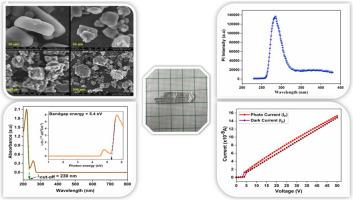非线性光学材料的综合评价:合成、生长、光谱、光致发光、LDT、光电导率、热、抗菌和二次谐波产生分析
IF 2.4
4区 物理与天体物理
Q3 PHYSICS, CONDENSED MATTER
引用次数: 0
摘要
低温溶液法是制备高质量硫酸双(d -苯甘氨酸)单晶的有效方法。x射线衍射分析表明,这种特殊的化合物明确地在单斜空间群P21内结晶。FT-IR和FT-Raman光谱证实了各种官能团的存在及其相应的振动模式。FT-NMR分析证实了合成材料中氢和碳原子的存在。该化合物的光学性质通过紫外可见吸收光谱进行了表征,截止波长为230 nm,带隙为5.4 eV,表明其具有良好的光学质量,具有潜在的应用前景。该材料的低乌尔巴赫能量意味着杂质最少,而光致发光测试显示出非凡的紫色发射,这一特性强调了其适用于NLO应用。HR-SEM和EDAX提供了深刻的图像,以显着的清晰度和分辨率阐明了样品的表面结构,复杂的形态和精确的元素组成。与同类材料相比,该材料具有10.7 GW/cm2的激光损伤阈值,具有显着的弹性。热重分析显示熔点为273℃,具有良好的热稳定性。对该材料光导性的研究揭示了其正光导行为,这是先进应用的关键特性。值得注意的是,该化合物对革兰氏阴性菌具有显著的抗菌效果,其SHG效率是标准KDP的1.3倍,突出了其在光子学和药物化学领域的潜力。本文章由计算机程序翻译,如有差异,请以英文原文为准。

A comprehensive evaluation of nonlinear optical materials: Synthesis, growth, spectral, photoluminescence, LDT, photoconductivity, thermal, antibacterial and second harmonic generation analysis
The low-temperature solution technique is an effective method for growing high-quality single crystals, such as Bis(D-phenylglycinium) sulfate monohydrate. This exceptional compound unequivocally crystallises within the monoclinic space group P21, as demonstrated by X-ray diffraction analysis. FT-IR and FT-Raman spectroscopy confirmed the presence of various functional groups and their corresponding vibrational modes. FT-NMR analyses verified the presence of hydrogen and carbon atoms in the synthesised material. The optical properties of the compound were characterised by the UV–Visible absorption spectrum, which revealed a cut-off wavelength of 230 nm and indicated a bandgap of 5.4 eV, suggesting superior optical quality for potential applications. The material's low Urbach energy implies minimal impurities, while photoluminescence testing revealed an extraordinary violet emission, a characteristic that underscores its suitability for NLO applications. HR-SEM and EDAX provided insightful images, illuminating the sample's surface structure, intricate morphology, and precise elemental composition with remarkable clarity and resolution. With an impressive laser damage threshold of 10.7 GW/cm2, this material exhibits a notable resilience compared to its counterparts. Thermogravimetric analysis revealed a melting point of 273 °C, indicating commendable thermal stability. Investigations into the photoconductivity of the material revealed its positive photoconductive behaviour, a crucial trait for advanced applications. Remarkably, this compound has demonstrated significant antibacterial efficacy against gram-negative bacteria, and its SHG efficiency measured at 1.3 times that of the standard KDP, accentuates its promising potential in the fields of photonics and pharmaceutical chemistry.
求助全文
通过发布文献求助,成功后即可免费获取论文全文。
去求助
来源期刊

Solid State Communications
物理-物理:凝聚态物理
CiteScore
3.40
自引率
4.80%
发文量
287
审稿时长
51 days
期刊介绍:
Solid State Communications is an international medium for the publication of short communications and original research articles on significant developments in condensed matter science, giving scientists immediate access to important, recently completed work. The journal publishes original experimental and theoretical research on the physical and chemical properties of solids and other condensed systems and also on their preparation. The submission of manuscripts reporting research on the basic physics of materials science and devices, as well as of state-of-the-art microstructures and nanostructures, is encouraged.
A coherent quantitative treatment emphasizing new physics is expected rather than a simple accumulation of experimental data. Consistent with these aims, the short communications should be kept concise and short, usually not longer than six printed pages. The number of figures and tables should also be kept to a minimum. Solid State Communications now also welcomes original research articles without length restrictions.
The Fast-Track section of Solid State Communications is the venue for very rapid publication of short communications on significant developments in condensed matter science. The goal is to offer the broad condensed matter community quick and immediate access to publish recently completed papers in research areas that are rapidly evolving and in which there are developments with great potential impact.
 求助内容:
求助内容: 应助结果提醒方式:
应助结果提醒方式:


